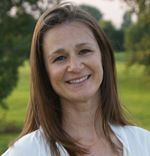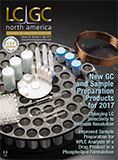Deirdre Cabooter: LCGC’s 2017 Emerging Leader in Chromatography Award Winner
How does the career of a young leader get started?

Deirdre Cabooter is an emerging leader in chromatography known for her work exploring the possibilities and limitations of the kinetic plot method for comparing the kinetic performance of chromatographic separation methods and columns. Joining the University of Leuven (KU Leuven) in 2011, where she is currently an associate professor, Cabooter has continued her stellar research and taken on responsibilities in the organization of the popular symposium series HTC. She recently spoke to LCGC about her career and work so far.
Were you always interested in a scientific career?
As a child, I either wanted to become a pilot (taking after my father) or do something with horses (I spent a large part of my childhood riding horses). My passion for science only developed during the last two years of high school, when we started studying genetics in biology, which fascinated me. This incited me to take on a bachelor’s and later a master’s degree in bioengineering, with a major in biotechnology.
How did you get started working with chromatography?
By the time I was halfway through my master’s studies, I had taken a lot of courses in immunology, virology, microbiology . . . then all of a sudden we began courses in biochemical engineering and downstream processing from a young professor called Gert Desmet. It was refreshing to take a course from this inspirational person who taught with such great passion. When he started talking about possible topics for a master’s thesis in his laboratory (at that time he was very much into shear-driven chromatography on microchips), I almost instantly decided this was the direction I wanted to take.
Who was the biggest influence on your career when you were just getting started?
For sure Gert Desmet. He was not just a great teacher, but also a fantastic supervisor. He was very supporting, enthusiastic, and always saw significance in the data we presented to him. I have never met someone so supportive and inspiring.
Why did you choose an academic career path?
I have always been very interested in research. I like the progress of figuring out unexpected data, or trying to come up with new solutions for problems. I also like the freedom-being able to pursue what we think is interesting. I feel very lucky being able to do what I love most as my job.
What has been the most challenging research project you have undertaken?
Probably one of our current research projects where we have tried to come up with solutions to combine orthogonal separation columns in series, and operate them using a single ultrahigh-pressure liquid chromatography (UHPLC) system. The biggest challenge here consisted of finding a solution to convert the mobile phase in between the columns online using a single pump, without adding excessive analysis time to the overall separation.
What has been the most rewarding?
Being able to carry out the above research project and, in particular, seeing my PhD student Glenn Loos succeed in creating a new mixing unit for this purpose.
You have taken on many PhD students in recent years. How have you dealt with the transition to mentor, what challenges have you faced, and how have your students impacted your career?
I have learned that doing research yourself is something completely different from managing people who do research. Fortunately, I have been lucky to have some fantastic people in my group, who are as passionate about research as I am. I have learned that there is nothing more rewarding than working with students who are on the same wavelength, and who are dedicated to reaching a common goal.
During your time at the Free University of Brussels, you worked with Gert Desmet and carried out research on the kinetic plot method. What are your memories of that period and how did they affect your career trajectory?
I started my PhD at the Department of Chemical Engineering together with six of my fellow students, who all graduated at the same time. We were very eager to learn and get into research, which created a great atmosphere wherein everyone wanted to move forward. It must have been one of the nicest, most stimulating environments I have ever worked in. I experienced the same atmosphere during the time I spent at the Pfizer Analytical Research Center that was run by Professor Pat Sandra at the University of Ghent, where I was surrounded by very inspirational scientists, such as Frédéric Lynen, André de Villiers, and Tadeusz Gorecki. Trying to recreate this atmosphere in my own research group is one of my current goals.
During your postdoctoral years you spent time in a few laboratories at different institutions around the world. How was that experience and what lessons did you learn from that period?
I met many fascinating people during that period, and many of them have become close friends, thanks to our shared passion for science. I have learned that it doesn’t really matter where I am in the world, as long as I can do what I like best: research.
In 2011 you took a position at the University of Leuven (KUL) and began to build a new team, broadening your research focus in the process. What challenges did this bring? And did you learn from the experience?
One of the biggest challenges was combining research and teaching. Especially in the beginning, I spent a lot of time preparing my courses. Finding my own niche in research and getting funding to support my research has been and still is a major challenge. Funding is scarce and competition is high. But I have learned to believe in myself, to learn from rejections, and to keep trying. In the end, something good will come out of it.
What advancements have come out of your recent research at KUL?
I have tried to apply some of my knowledge to the challenging separation problems I have come into contact with since I started working at KUL. This has led to the development of new approaches to multidimensional analysis for samples with a large variety in polarity, such as emerging micropollutants and their degradation products in wastewater, the application of capillary liquid chromatography (LC) and microfluidics for samples that are available in small sample volumes only, and new concepts for automated method development. Meanwhile, I have also tried to expand my understanding of mass-transfer phenomena in LC.
You have also taken on responsibility for organizing the popular symposium series, International Symposium on Hyphenated Techniques in Chromatography and Separation Technology (HTC). How did you get involved in the organization of HTC and what are the biggest challenges in organizing such an event?
Frédéric Lynen, who has been a dear friend of mine for many years now, took on the chairmanship of HTC after the unexpected passing of Robert Smits in 2011. In 2012, he asked me, Bas Eeltink, Joeri Vercammen, and later Ken Broeckhoven to join the organizing committee of HTC. Since then, we have tried to further strengthen the concept of HTC, which brings together advances in chromatography in industry and academia. We have put more focus on the active participation of young researchers and try to come up with new concepts, such as the “Battle of the Gurus” at our latest edition. The biggest challenge is to create a stimulating environment, full of interesting research, where everyone has ample opportunity to interact, eat good food, and go home satisfied.
You have a strong background in engineering, how has this helped your research in analytical chemistry?
I think as engineers, we are not afraid to take down an instrument, build it up again in a completely different way, taking out or adding a few pieces; or to do strange things to columns, such as opening them up to see what is going on inside them. In many cases, very interesting things come out of such experiments.
If you had to pick one of your publications to highlight which one would it be?
In a recent publication in Analytical Chemistry, we developed and applied a protocol to strip away the C18 coating of a reversed-phase LC column to obtain a hydrophilic interaction chromatography (HILIC) column with exactly the same packing characteristics as the reversed-phase LC column. This has allowed us to study mass-transfer phenomena in HILIC and reversed-phase LC, without having to worry about differences in packing structure. I’m particularly proud of this paper, since it has been such a nice collaboration between my post-doc Huiying Song, who performed all the experiments with such care and detail, Gert Desmet, and myself. I especially remember how surprised we were when we found out that we were able to “create” a HILIC column out of a reversed-phase LC column, without destroying the structure and performance of the column (1).
What are your plans for the future? Starting a company? New research directions?
I will go where my research takes me, hopefully surrounded by all the amazing people who I have met and been privileged to work with so far, and in good health.
Reference
- H. Song, G. Desmet, and D. Cabooter, Anal. Chem. 87, 12331–12339 (2015).
This interview has been edited for length and clarity. For more information on our 2017 LCGC award winners, please visit www.chromatographyonline.com/2017-lcgc-awards-0.
To nominate a friend or colleague for the 2019 Emerging Leader in Chromatography Award, please visit our call for nominations page at www.chromatographyonline.com/2019-emerging-leader-chromatography-call-nominations
To see a complete list of previous LCGC Award winners, please visit www.chromatographyonline.com/node/320163

Understanding FDA Recommendations for N-Nitrosamine Impurity Levels
April 17th 2025We spoke with Josh Hoerner, general manager of Purisys, which specializes in a small volume custom synthesis and specialized controlled substance manufacturing, to gain his perspective on FDA’s recommendations for acceptable intake limits for N-nitrosamine impurities.
University of Rouen-Normandy Scientists Explore Eco-Friendly Sampling Approach for GC-HRMS
April 17th 2025Root exudates—substances secreted by living plant roots—are challenging to sample, as they are typically extracted using artificial devices and can vary widely in both quantity and composition across plant species.
Determining the Serum Proteomic Profile in Migraine Patients with LC–MS
April 17th 2025Researchers used liquid chromatography–mass spectrometry (LC–MS) in their proteomic analysis to compare the serum proteome of migraine patients with healthy controls and to identify differentially expressed proteins as potential migraine biomarkers.














